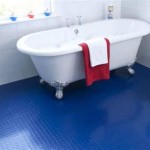Grout For Vinyl Tile Flooring: A Comprehensive Guide
Vinyl tile flooring, known for its durability, water resistance, and aesthetic versatility, has become a popular choice for residential and commercial spaces alike. While the material itself offers numerous advantages, the success of a vinyl tile installation often hinges on the proper selection and application of grout. Selecting the appropriate grout type and executing a meticulous grouting process are crucial for achieving a professional, long-lasting, and aesthetically pleasing finish. This article provides a comprehensive guide to understanding the role of grout in vinyl tile flooring, exploring different grout options, and outlining best practices for a successful installation.
The Purpose of Grout in Vinyl Tile Installations
Grout serves several essential functions in a vinyl tile flooring system, extending beyond merely filling the gaps between tiles. Understanding these functions is vital for appreciating the importance of proper grout selection and application.
Firstly, grout provides structural stability. By filling the spaces between tiles, it creates a unified surface that distributes weight evenly. This reduces the stress on individual tiles, minimizing the risk of cracking, chipping, or becoming dislodged over time. Without grout, the edges of the tiles would be vulnerable to damage from foot traffic and furniture.
Secondly, grout acts as a barrier against moisture and debris. Vinyl tile is inherently water-resistant, but the seams between tiles present potential entry points for water, spills, and dirt. Grout seals these gaps, preventing water from seeping beneath the flooring and potentially damaging the subfloor. This is particularly important in areas prone to moisture, such as bathrooms, kitchens, and laundry rooms. Furthermore, grout prevents the accumulation of dirt and grime in the tile joints, making the floor easier to clean and maintain.
Thirdly, grout contributes significantly to the overall aesthetic of the floor. The color and texture of the grout can either complement or contrast with the vinyl tiles, creating a desired visual effect. A carefully chosen grout color can enhance the tile's natural beauty, create a sense of continuity, or add a touch of visual interest. The grout lines themselves can also influence the perceived size and shape of the room. Narrow grout lines tend to create a more seamless look, while wider lines can emphasize the individual tiles.
Exploring Different Types of Grout for Vinyl Tile
Several grout types are available for vinyl tile flooring, each with its own unique properties and suitability for different applications. The choice of grout will depend on factors such as the type of vinyl tile, the expected traffic, and the desired aesthetic.
Cement-based grout is the most common and widely used option. It is composed of cement, sand, and pigments, and is available in a variety of colors. Cement-based grout is relatively inexpensive, easy to apply, and provides good durability for general use. However, it is porous and susceptible to staining and discoloration over time. Sealing cement-based grout is essential to protect it from moisture and stains.
Epoxy grout is a more expensive but also more durable option. It is composed of epoxy resins and hardeners, creating a waterproof, stain-resistant, and chemical-resistant seal. Epoxy grout is ideal for high-traffic areas, environments with frequent spills, and installations exposed to harsh cleaning chemicals. It is also less prone to cracking and shrinking compared to cement-based grout. However, epoxy grout can be more challenging to apply due to its rapid setting time and sticky consistency.
Pre-mixed grout, often acrylic-based, is a convenient option for smaller projects and DIY installations. It eliminates the need for mixing and offers a consistent color and texture. Pre-mixed grout is generally water-resistant and stain-resistant, but may not be as durable as cement-based or epoxy grout. It is typically more expensive per unit than traditional grout options.
Unsanded grout is recommended for vinyl tiles with narrow grout lines, typically 1/8 inch or less. The absence of sand prevents scratching and damage to the tile surface during application. Conversely, sanded grout is suitable for wider grout lines, providing additional strength and preventing cracking.
When selecting a grout type, it is important to consider the manufacturer's recommendations for the specific vinyl tile being used. Some vinyl tiles may be incompatible with certain grout types, potentially causing discoloration, adhesion problems, or damage to the tile surface. Consulting with a flooring professional can provide valuable guidance in selecting the most appropriate grout for a given application.
Best Practices for Grouting Vinyl Tile Flooring
A successful grouting process is essential for achieving a durable, aesthetically pleasing, and long-lasting vinyl tile floor. Following best practices during preparation, application, and clean-up will minimize potential problems and ensure a professional finish.
Prior to grouting, the vinyl tile installation must be fully cured according to the manufacturer's instructions. This typically involves allowing the adhesive to dry completely, ensuring that the tiles are firmly bonded to the subfloor. Any loose or uneven tiles should be addressed before proceeding.
Thoroughly clean the tile surface, removing any debris, dust, or adhesive residue. Vacuum the floor and wipe it down with a damp sponge or cloth. Ensure that the grout lines are free of obstructions.
Mix the grout according to the manufacturer's instructions, using the recommended water-to-grout ratio. Overwatering can weaken the grout and lead to cracking, while undervatering can make it difficult to apply. Use a mixing drill with a paddle attachment to achieve a smooth, consistent consistency.
Apply the grout using a rubber grout float, holding it at a 45-degree angle to the tile surface. Work the grout into the joints, filling them completely and removing any excess grout from the tile surface. Apply firm pressure to ensure that the grout is properly compacted into the joints.
After applying the grout, allow it to set for the recommended time, typically 15-30 minutes. Use a damp sponge to wipe away excess grout from the tile surface, rinsing the sponge frequently in clean water. Avoid using too much water, as this can weaken the grout. Wring out the sponge thoroughly after each rinse.
After the initial cleaning, allow the grout to haze over, typically within 1-2 hours. Use a clean, dry cloth to buff the tile surface, removing the remaining grout haze. This step is crucial for achieving a clean, polished finish.
Allow the grout to cure completely according to the manufacturer's instructions, typically 24-72 hours. Avoid walking on the floor during the curing period. Once the grout is fully cured, apply a grout sealer to protect it from moisture and stains. Follow the sealer manufacturer's instructions for application and reapplication frequency.
Regular cleaning and maintenance are essential for preserving the appearance and longevity of the grout. Sweep or vacuum the floor regularly to remove dirt and debris. Clean the grout lines with a mild detergent and a grout brush. Avoid using harsh chemicals or abrasive cleaners, as these can damage the grout sealant and discolor the grout. Consider using a grout colorant or restorer to refresh the grout color and conceal stains.
Pay special attention to expansion joints, which are gaps left intentionally in the flooring to accommodate expansion and contraction due to temperature and humidity changes. These joints should not be filled with grout, but rather with a flexible sealant, such as silicone caulk. Installing the wrong material into those joints could cause the tiles to lift or crack with normal expansion/contraction. Filling the joints with grout will not allow for the movement they are designed for. Correctly filling them with a flexible sealant is critical for the lifespan of the flooring.
By carefully selecting the appropriate grout type and following best practices for application and maintenance, homeowners and contractors can create vinyl tile floors that are not only beautiful but also durable, water-resistant, and easy to maintain. A well-grouted vinyl tile floor will provide years of enjoyment and value.

How To Grout L And Stick Vinyl Tile Self Seam Guide

Diy Grouted Vinyl Floor Tiles Show Off Decorating And Home Improvement Blogdiy Blog

Grout Ing Between Our Vinyl Resilient Tiles Merrypad

Groutable Luxury Vinyl Tile Floor An Update Jenna Burger Design Llc Interior Architectural Consulting

L And Stick Groutable Vinyl Tile Do They Last 4 Years Later This Diy Life

How To Install Luxury Vinyl Tile With Grout

How To Install Groutable Vinyl Floor Tile Subway Pattern Flooring Tiles

Vinyl Tile Grout Tec

How To Grout L And Stick Tiles A Easy Floor Update 50 One Afternoon Of Work This Diy Life

Diy Grouted Vinyl Floor Tiles Show Off Decorating And Home Improvement Blogdiy Blog
Related Posts








